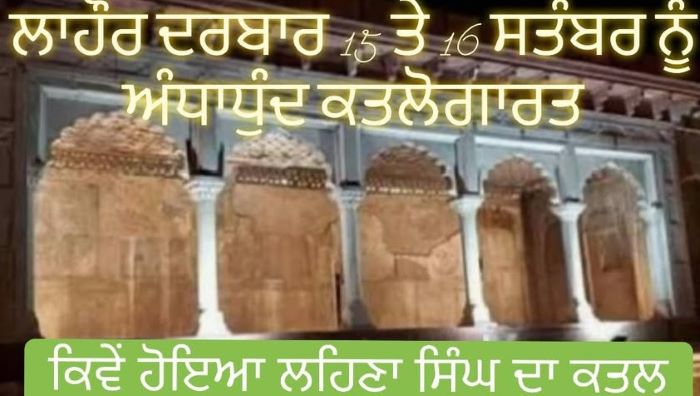 The mid-19th century in Punjab was a time of political intrigue, palace conspiracies, and volatile ambitions. Among the most tragic episodes of this period was the massacre at Lahore Darbar on September 16, 1843, a day remembered for betrayal, bloodshed, and heroic loyalty.
The mid-19th century in Punjab was a time of political intrigue, palace conspiracies, and volatile ambitions. Among the most tragic episodes of this period was the massacre at Lahore Darbar on September 16, 1843, a day remembered for betrayal, bloodshed, and heroic loyalty.
The Night of Darkness
On the night of September 15, 1843, Lahore’s streets fell silent under an ominous shadow. The city’s vibrant life was subdued as whispers of treachery grew louder within the palace. According to historian Syed Muhammad Latif, traitorous elements of the army orchestrated the murders of Maharaja Sher Singh, Tikka Pratap Singh, and Dogra Wazir Dhyan Singh, paving the way for Hira Singh, Dhyan Singh’s ambitious son, to manipulate the army and seize power.
Amid this chaos stood Sardar Lehna Singh and his loyal protector, Rah Singh, ready to defend the fort against Hira Singh’s encroaching forces. With Sardar Ajit Singh and roughly one thousand soldiers, they fortified the Darbar, preparing for what would become a desperate, life-or-death struggle.
The Siege and Heroism
By dawn on September 16, the fort bore the scars of relentless cannon fire. A large breach appeared in the walls, allowing Hira Singh’s army to enter. Sardar Ajit Singh, with his trusted companion Mahar Ghasita, climbed the fort wall, only to be pursued and killed by enemy soldiers. Ajit Singh’s severed head was presented to Hira Singh, signaling a grim turning point.
The search then focused on Lehna Singh, who had vanished amid the carnage. Finally, soldiers discovered her hiding in darkness, thigh broken, guarded by Rah Singh, a veteran warrior of fifty years. Armed with only a naked sword, Rah Singh faced the enraged attackers. In a remarkable act of bravery, he killed thirteen enemy soldiers before succumbing to his wounds, leaving behind his final plea: “Let no harm come to Lehna Singh.”
Despite the soldiers’ efforts to protect her, Lehna Singh was tragically killed by an impatient soldier seeking reward. Their deaths exemplify both the human cost of ambition and the extraordinary courage of those who remain loyal against overwhelming odds.
Political Fallout
The massacre dramatically reshaped Lahore Darbar’s political landscape. Hira Singh’s ruthless ambition temporarily consolidated power but fractured the army and created deep resentment among loyalists. Witnessing the heroism of Rah Singh and Lehna Singh, many began questioning Hira Singh’s legitimacy and morality.
This instability weakened centralized authority in Punjab, leaving the region more vulnerable to internal conflicts and external threats, including eventual British intervention. The events of September 16 became a turning point, demonstrating the deadly intersection of ambition, betrayal, and loyalty in Sikh history.
Rah Singh: The Loyal Protector
Rah Singh, a seasoned warrior in his fifties, exemplified courage, discipline, and unwavering loyalty. Born into a martial family, he trained rigorously in swordsmanship, strategy, and leadership. Known for his iron will and calm demeanor, Rah Singh served decades defending the Sikh Empire, always placing duty and loyalty above personal safety.
At Lahore, his bravery reached legendary heights. Guarding Lehna Singh with a naked sword against overwhelming odds, he killed thirteen attackers before dying from his wounds. His last words, ensuring the safety of his master, remain a symbol of unflinching fidelity and moral courage, inspiring generations of Sikhs to value honor above life itself.
Lehna Singh: The Noble Survivor
Sardar Lehna Singh, a respected noble of Lahore Darbar, was celebrated for his wisdom, courage, and leadership. Even with a broken thigh, he remained composed, embodying resilience and moral fortitude. Trusted by soldiers and peers alike, Lehna Singh inspired loyalty through both words and deeds.
Though his life was tragically cut short, his legacy lives on as a symbol of honor, bravery, and steadfastness, demonstrating that true heroism lies not in survival alone but in the courage to face danger with integrity.
A Legacy of Courage and Loyalty
Together, Lehna Singh and Rah Singh epitomize the highest ideals of the Sikh warrior tradition: loyalty, courage, and moral steadfastness. Their story is more than a historical event; it is a testament to the human spirit’s resilience in the face of treachery and death. Even amid the darkness of betrayal, their courage shines as a timeless beacon, reminding us that honor and fidelity endure beyond the mortal cost.